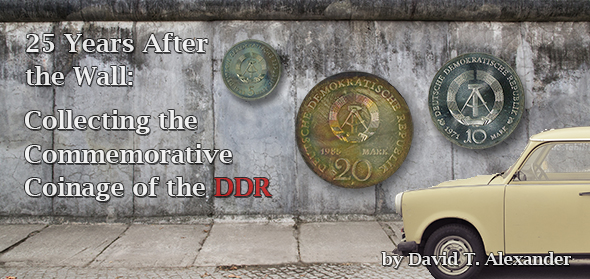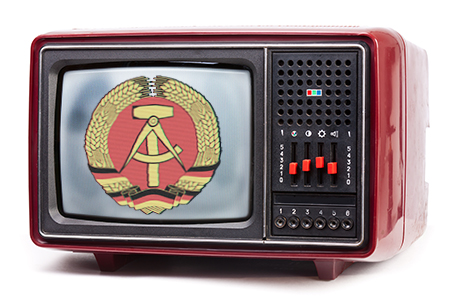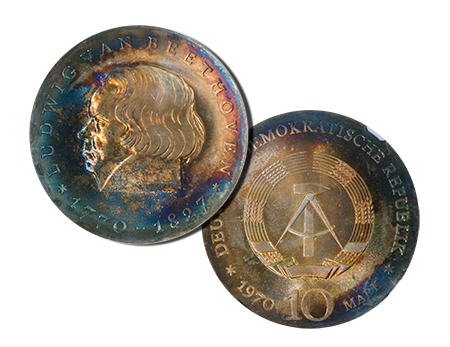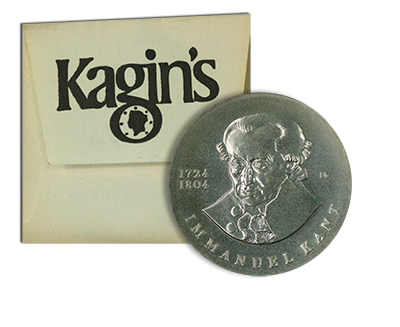
By David T. Alexander for CoinWeek….
Oct. 3, 1990 was an historic date for Germany and the world as the five constituent provinces of the former German Democratic Republic (Deutsche Demokratische Republik, DDR or East Germany) gained admission to the Federal Republic of Germany, thus ending nearly 50 years of division growing out of catastrophic defeat in the Second World War.
Unification also ended East German coinage that began in 1948 and a commemorative coin series initiated in 1966. Many collectors seek to complete series with clearly defined beginnings and endings, and the DDR coinage is certainly a candidate for such interest. Assembling a complete type collection of this complex country is certainly possible.
East Germany’s modern story began as the Allies closed in on Hitler’s Third Reich in the spring of 1945. It soon became evident that they had no coherent vision for reconstructing post-war Germany. The defeated nation was divided into American, British, French and Soviet occupation zones with the vague hope of developing a unified policy for the country’s future.
The U.S. was abandoning the Morgenthau Plan for a disarmed, de-industrialized, agricultural Germany but had not yet formulated any workable alternative. The British and French were starting to struggle with their own severe post-war crises as well as governing their occupation zones.
The Soviet Union paid lip service to a united and demilitarized Germany but was determined to achieve a communist German state. The Soviet occupation zone embraced all territory east of the Elbe River and communist Poland had already seized all German territory east of the Oder-Neisse line and was expelling the German population westward into the former Reich.
One inter-Allied program that started well was the printing and circulating of military occupation currency inscribed Aliierte Militärbehörde, printed in the U.S. This currency was initially tightly controlled to cripple the black market, head off inflation and speed the revival of the German economy.
This careful policy was derailed when Secretary Henry Morgenthau, acting on his own authority, sent glass printing plates to the Russians who promptly printed vast quantities of unsecured occupation notes and effectively wrecked this promising program. Cooperation in most areas was now abandoned as the Cold War clamped down on Eastern Europe, resulting in such measures as the Berlin airlift.
 Unilateral action soon shaped a divided future. Soviet Military Administration Order 111 of June 23, 1948 decreed a drastic currency reform for its zone to be carried out between June 14 and June 28. Validating Coupons had to be attached to all circulating Rentenmark, Reichsmark and Allied Military currency notes, making them useless outside the Soviet area. Coins still in use kept their face value for the moment.
Unilateral action soon shaped a divided future. Soviet Military Administration Order 111 of June 23, 1948 decreed a drastic currency reform for its zone to be carried out between June 14 and June 28. Validating Coupons had to be attached to all circulating Rentenmark, Reichsmark and Allied Military currency notes, making them useless outside the Soviet area. Coins still in use kept their face value for the moment.
Military Administration Order 122 of July 20 created a new issuing authority, the Deutsche Notenbank whose currency unit would be called Mark der Deutsche Notenbank (MDN). This agency continued as bank of issue until Jan. 1, 1968, when it was replaced by a new institution, the Staatsbank der DDR.
The Allied occupation zones coalesced and in May 1949 ratified a constitution or Grundgesetz establishing a new democratic Federal Republic of Germany (Bundesrepublik Deutschland, BRD.) This new West Germany had 45 million inhabitants compared to 18 million in the East though both were in ruins.
Its new currency was the Deutsche Mark that promptly became one of the engines of the Wirtschaftswunder, the Economic Miracle that made West Germany a financial powerhouse of Europe and the world. West Germany outlasted Soviet opposition and by May 1955 was fully sovereign with Chancellor Konrad Adenauer becoming an official visitor to the U.S.S.R.
The situation in the east was more difficult, with frequently blockaded Berlin sitting like an island in its middle divided into four mini-zones and claimed as capital by West and East Germany.
The creation of a communist state was expedited by the Soviets who founded the Socialist Unity Party of Germany (Sozialistische Einheitspartei Deutschlands, SED) to rule the east.
SED was formed by the forced unification of the Communist Party of Germany and the Social Democratic Party in time for the 1948 People’s Congress. Only 66.1% of voters approved the official list, but on Oct 7, 1949 the DDR was proclaimed with nominal Socialist Otto Grotewohl as minister president, Communist Wilhelm Pieck as president.
The new state was crippled at birth by the Soviet looting of its industries after 1945 and by disruption of agriculture on the North German Plain by communist land reform and collectivization. The perpetual question it would always face was whether East Germany should exist at all.
Was the East part of the continuing German fatherland or wholly separate? East Germany announced early on that it would accept no share of the responsibility for World War II and the attempted extermination of the Jews. But both east and west used the same flag, the black-red-gold of the liberal revolution of 1848 and of the Weimar Republic. Should it confront West Germany at every chance or cooperate in safe areas such as the Olympic Games?
On Stalin’s death, serious resistance in June 1953 let to the East German Uprising, suppressed by Soviet tanks and troops. Otto Grotewohl died in 1965, succeeded by hardliner Erich Honecker; the unsmiling Walter Ulbricht was first secretary after 1954. Willi Stoph was effectively prime minister in 1970. All strove to preserve the regime and keep its citizens inside its borders, finally by building the Berlin Wall, formally the “Anti-Fascist Defense Wall.”.

West German Chancellor Willi Brandt strove for détente and in September 1987 Honecker paid an official visit to West Germany. Mikhail Gorbachev began dissembling the Soviet Union. Communist one-party rule ended in Hungary in May 1988 and thousands of East Germans fled via Austria. Gorbachev attended the 40th anniversary celebration of the DDR on Oct. 8, and Honecker resigned on October 18.
On November 9 the Berlin Wall fell, emblem of East German isolation and national repression. The communist politburo resigned and the first general election on March 18 saw West German Chancellor Helmut Kohl receive 48.1 percent of the vote, the independent Socialists, 21.8 percent. On Aug. 23 the DDR Volkskammer voted for unification but on Oct 3 the five eastern provinces were admitted separately into the Federal Republic and the DDR ceased to exist.
The German Democratic Republic’s coinage history was short but has been well charted. In 1948-1950 East German coins first appeared in the wake of the Soviet currency reform. Aluminum one, five and 10 pfennig bearing the gear and wheat ear of the Two Year Plan were struck at Berlin (Mint mark A) and Muldenhütten, E). Coins of 1952-53 with the same alloy and denomination bore the wheat ears, compass and hammer of the Five Year Plan.
A scarce 1949-50 aluminum-bronze 50 pfennig depicted smoking factories and farm equipment symbolizing union of workers and peasants. Perhaps reflecting basic identity questions, the country’s name first appeared on the coins as simply DEUTSCHLAND, Germany.
Beginning in 1956 the coins presented the DDR state emblem in a wheat circle, surrounded by the full name DEUTSCHE DEMOKRATISCHE REPUBLIK. New aluminum two and one-mark coins of 1956-1957 were introduced, somewhat confusingly inscribed DEUTSCHE MARK, like the stronger West German coinage unit. East German coins after 1972 dropped DEUTSCHE.
In 1966 East German commemorative coins or Gedenkmünzen began to appear and continued until 1990. Obtaining hard data on East German coinage was virtually impossible until 1990. One influential seeker was the dean of German numismatists Kurt Jaeger (1909-1975), whose first edition of Deutsche Reichsmünzen seit 1871 appeared as early as 1942.
He sought numbers struck and other basic information on DDR issues without cooperation from East Berlin. Jaeger’s cataloging of commemoratives followed the official division of Gedenkmünzen into two categories, coins that could have circulated (generally in base metal) and Münzen, die nicht für Zahlungsverkehr bestimmt sind, Coins not intended for daily circulation.
This distinction has been largely discarded today. All East German commemoratives were struck at Berlin, many still bearing the A mintmark though no other Mints were in service. The Mint boasted an ambitious engraving and design staff which produced exceptional quality work, including such prolific artists as Wilifried Fitzenreiter, Axel Bertram, Gerhard Rommel and Dietrich Dorfstecher.
 A variety of alloys was used, depending on the intended place of sale of the coins. East German citizens could generally obtain base metal coins but silver pieces were intended to export and the raising of hard currency for official coffers. Five mark pieces (29 millimeters) were struck in copper-nickel, nickel-bronze and copper-nickel-zinc or Neusilber. 10 mark (31mm) were struck in .800 silver, .625 silver, .500 silver, copper-nickel, copper-nickel-zinc.
A variety of alloys was used, depending on the intended place of sale of the coins. East German citizens could generally obtain base metal coins but silver pieces were intended to export and the raising of hard currency for official coffers. Five mark pieces (29 millimeters) were struck in copper-nickel, nickel-bronze and copper-nickel-zinc or Neusilber. 10 mark (31mm) were struck in .800 silver, .625 silver, .500 silver, copper-nickel, copper-nickel-zinc.
The highest face value was 20 mark (33mm), struck in .800 silver, .625 silver, .500 silver and copper-nickel. Following eastern bloc practice, a number of types also appeared as Proben, Proof-pattern strikes offered at increased cost, generally sold in rigid plastic holders with wax seals.
A powerful inducement to unity was the promise of exchange of east marks for west marks one for one. Soon after unification, all DDR coins and notes above 1 mark not yet redeemed were demonetized, and coins followed, disappearing into refineries to form a ceaseless cataract of molten aluminum.
Beginning April 1994 was a truly remarkable event, a series of sales of the holdings of the Münzarchiv der Staatsbank, the former DDR bank of issue. Tens of thousands of unsold “remainder” coins, including commemoratives, sets, paper notes and Proben were cataloged by German professional numismatist Gunther Schön for auction by Dr. Busso Peuss Nachf, in Frankfurt am Main in a series of sales entitled Restbestände der Staatsbank Berlin. These catalogs included a wealth of information long sought on numbers struck and sold, melted or otherwise disposed of.
A review of some of representative Gedenkmünzen will give the flavor of the subject matter and designs. Internationally famed artists, musicians, scientists jostle with socialist and German Communist leaders, technological advances, historic cities and locales.

American collectors probably find the Krause-Mishler Standard Catalog of World Coins order of listing simple: denomination from smallest (5 Mark) to largest (20 mark), subjects and dates within the denomination run.
20 Mark Commemoratives:
- Fitzenreiter and Bertram (F4) designed the 1971 .625 silver 20 mark of ultra-leftist leaders Karl Liebknecht and Rosa Luxemburg, killed by government troops in Berlin on Jan. 15, 1919. The reverse presents DDR emblem and name.
- Philosopher Immanuel Kant stares relentlessly from the same artists’ obverse of the 1974 20 mark. Both silver pieces exhibit the concave fields used on so many DDR commemoratives.
- Struck in Copper-nickel-zinc is the 1971 20 mark portraying German Communist leader Ernst Thälmann (1886-1944), shot at Buchenwald concentration camp in 1944.
- Poet Friedrich von Schiller graces the copper-nickel 1972 20 mark by Fitzenreiter and Bertram. 7.4 million struck, 3.8 million melted.
- First DDR President Wilhelm Pieck is honored on the 1972 copper-nickel 20 mark.
10 Mark Commemoratives:
- Denominated 10 MDN is this Matte Proof .800 silver coin honoring the 125th death anniversary of classical architect Karl Friedrich Schinkel. First DDR non-circulating legal tender commemorative.
- Composer Ludwig van Beethoven appears on this .625 silver 1970 10 mark with concave fields.
- Renaissance giant Albrecht Dürer’s distinctive monogram graces the .625 silver 10 mark of 1971
- Theologian and missionary Dr. Albert Schweizer appears on this 1975 .625 silver 10 mark.
- Facing scientist Justus von Liebig appears on this 1978 .500 silver 10 mark designed by Rainer Radack and Erika Schöneberg.
- Monument to Buchenwald concentration camp and its victims appears on this copper-nickel-zinc 1972 10 mark.
- Typical of sport themes is this copper-nickel-zinc 1973 10 mark for the World Youth and Student Games in Berlin.
- Copper-nickel-zinc 1974 10 mark celebrated 25 years of the DDR.
- 25th Anniversary of the Warsaw Pact was hailed by this 1975 copper-nickel-zinc 10 mark.
Five Mark Coins:
- West Germany celebrated 100 years of German unification in 1971; a copper-nickel-zinc East Germany 5 mark hailed “Berlin Capital of the DDR” and partition.
- Writer and Nobel Laureate Thomas Mann is hailed on this 1975 copper-nickel-zinc 5 mark.
- Women of three races grace the copper-nickel-zinc 5 mark for 1975 International Women’s Year.
- Founder of the Gymnastic Union, Germany’s Turnvater Friedrich Ludwig Jahn appears on this prooflike 1977 copper-nickel-zinc 5 mark.
- The Baltic Port of Rostock is honored by this copper-nickel 5 mark of 1988, part of a places and events series.




